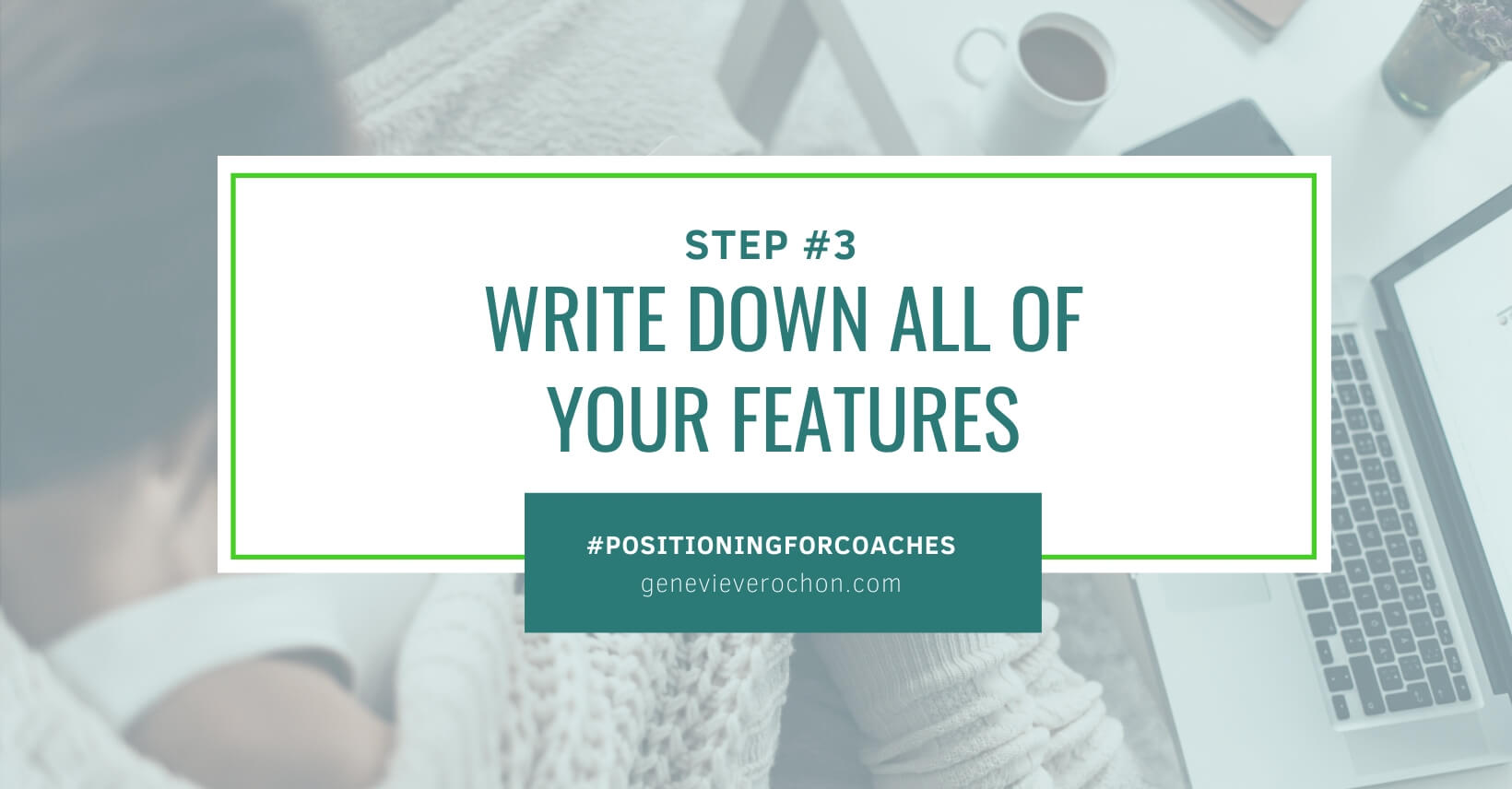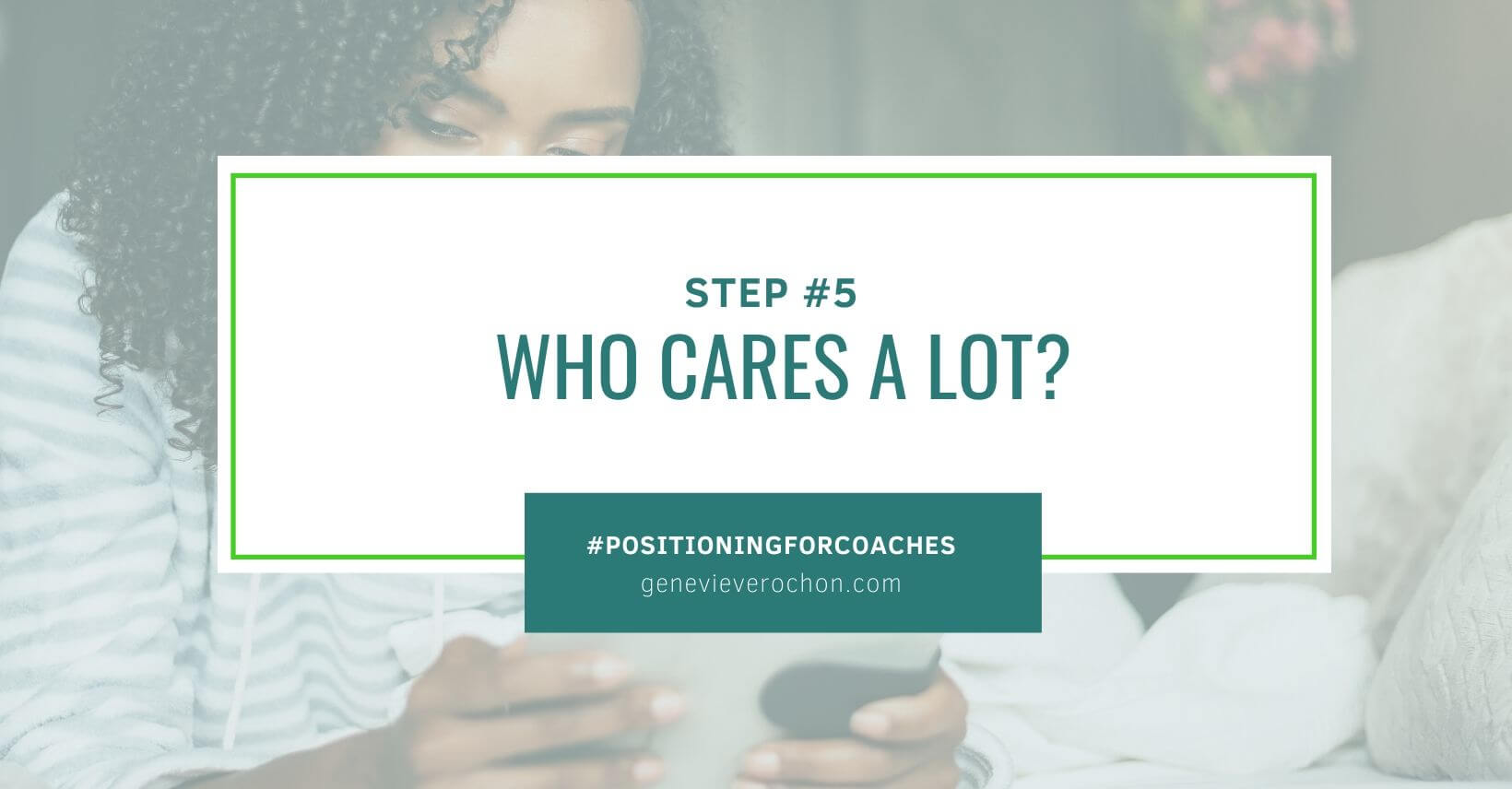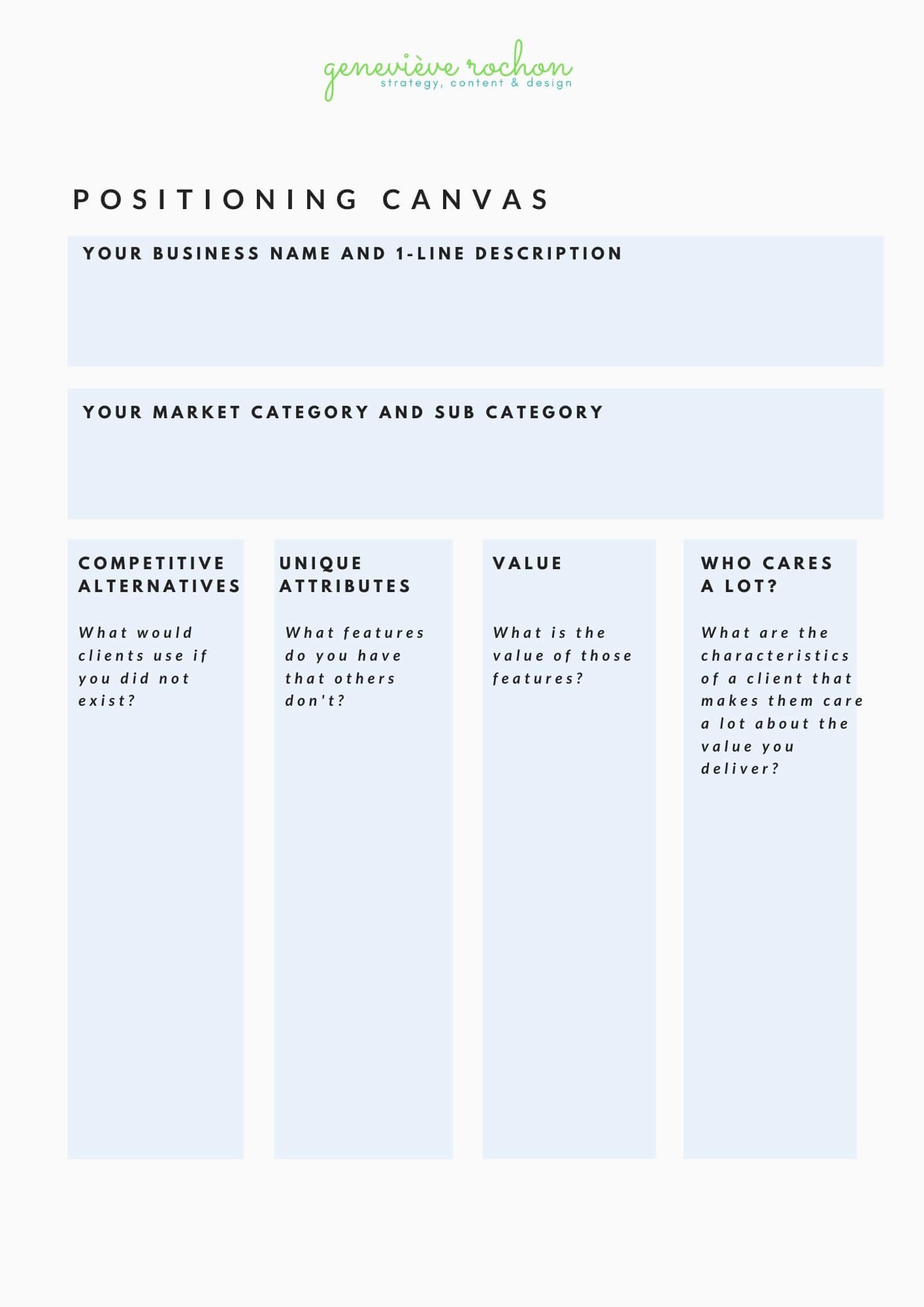[Updated Nov 2022 – 10 minute read]
Why use positioning for coaches and speakers?
Positioning is a marketing term that may not make a lot of sense to coaches and speakers. Often we like to separate ourselves from icky ‘marketing’ and ‘sales’ processes that don’t seem to be authentic or fit into our services of transformational learning and development.
But in a world where there are coaches who coach coaches who coach coaches, and ‘best selling authors’ around every corner, it’s more important than ever to learn what positioning is, and why it matters.
What is positioning?
Positioning is traditionally defined as “the place that a brand occupies in the mind of its target audience and how it is distinguished from the products of its competitors”.
But when we think about positioning for coaches and speakers, we can perhaps frame it this way:
Positioning describes your differentiator – how you are uniquely qualified to be a leader in something that an identified group of people cares a lot about
Ultimately positioning is a thought-out way of presenting yourself to the world – with the aim of creating better connection, more trust, and of course – sales!
And to be even more specific, this “thought-out-way-of-presenting-yourself” usually ends up being a document that you can use to create your marketing messaging, and that you can share with others who are working with you.
It provides a clear, quick snapshot of you and your work, and keeps you and your team on track.
Why is positioning important for coaches and speakers?
Positioning allows us to think about and describe what we are uniquely qualified to do (the results we can achieve) within the context of “who cares”?
And that’s where the magic happens. Who cares, indeed?
When we can identify *what we do that’s different* and pair it with *the people who really care a lot about that thing* we have a place to plant our flag – a platform to speak from – an audience that wants to listen – and a message that helps us to connect and transform lives.
As a marketer who works with coaches and speakers, I know that positioning is the foundation for all of the work we will do together. It will help us to stand out from the crowd, and it will inform everything we do, from building programs, websites, and content calendars, to choosing social media platforms and media outlets.

Shout out to April Dunford!
The positioning work I do with clients owes a huge debt of gratitude to April Dunford’s amazing book “Obviously Awesome – How to Nail Product Positioning so Customers Get It, Buy It, Love It” and I highly recommend reading this book if you are interested in the subject.
While April’s work concentrates on B2B products and tech startups it can be used universally and I have adapted her solid principles to speak to the unique issues that coaches and speakers come up against in their marketing.
As April so aptly puts it
Marketing with weak positioning is like making an omelet with rotten eggs. Your cooking technique might be perfect but nobody wants to eat what you’re serving. Weak positioning will drag down the performance of everything marketing and sales are trying to accomplish. Strong positioning, on the other hand, is like running with the wind at your back. Everything is easier and your results in sales and marketing will show it.
So let’s run with the wind at our back!
Why is positioning hard for coaches and speakers?
Coaches and speakers can sometimes have a hard time getting started with positioning. Because we are so passionate about what we do and our core values generally involve teaching and helping others, we can often feel like we want to serve “everybody”.
But serving everybody does not serve us!
At the core of a great marketing strategy for a coach or a speaker is a clear and detailed definition of who we serve and what value we can bring to them. When we can nail that down, we open the door to authentically connecting, communicating, and ultimately selling our services.

Positioning vs. Niching – What’s the difference?
Most coaches have heard that “niching down” is the key to success, and there are countless articles and gurus talking about how you need to narrow down your focus in order to reach your audience. I agree that finding your niche is necessary, but positioning is where we start.
The difference between positioning and niching is that positioning at its heart begins with listening to your clients (or potential clients) and getting a deeper understanding of what they value in you, and then pairing the unique benefits you offer to meet their needs within the framework of a particular market. Once you understand this at a deep level, you can then CHOOSE a niche that will fit with your coaching business.
Niching is second. Positioning is first. If niching is done first, you run the risk of speaking to a group of people who neither want your solution, nor understand your point of view. When positioning is done first, it makes your niche obvious and congruent.
How to figure out your positioning: A 6 Step Process
I work with clients using a 6 step process to create their positioning document, which we use as an invaluable tool in almost every part of their business, and I’m going to break it all down for you here!
Based on April Dunford’s 10-Step Process, I’ve simplified a little (6 steps!), and focused on what will help coaches and speakers the most.

Step 1 – Interview your “best fit” clients
Depending on where you are in your journey, you might want to interview your own “best fit” clients, or, if you are just starting out, you can interview people who fit the profile of your ideal clients.
Who are these people? Usually the ones who you love working with, who really appreciate what you do, who are more than willing to pay your prices, and who recommend you to others.
If you don’t have these clients yet, you can interview people who you assume would have these qualities. I always suggest recording the interviews so you can relax while chatting without having to take notes.
Interview questions can vary, but here are some essentials to get you started:
- What was going on in your life when you decided you needed to get some help with (the problem you solve)?
- Had you tried to solve this problem in the past, and was it successful?
- Where / how did you look for something to solve your problem?
- What kind of solutions did you try? Did they work?
- What alternatives did you consider, and what made you choose me?
- How did you feel when you were working with me? What was the end result?
- What were the biggest benefits of working with me? How did I help solve your problem?
Coaches who hire me for a positioning workshop are provided a fully customized question list, and have the opportunity to do the interview themselves, or have my team conduct interviews for them. All the interviews are recorded and transcribed so we can easily refer back to them.

Step 2 – List the Benefits and the Alternatives
Look over the answers from your interviews and write down your insights. Remember, our clients don’t always see us (and our competition) the same way we do, and their opinion is key when we are positioning. Be open!
Make a list of:
THE BENEFITS
List all the benefits they mentioned about working with you. Do you see any patterns here?
THE ALTERNATIVES – YOUR TRUE COMPETITION
What were the TRUE alternatives to using your coaching service? This list is our actual competition. Sometimes we THINK we know what our competition is, but often we are surprised. Was “doing nothing” an alternative? (Often it is!). Apart from other coaches or speakers, your competition could be “talking to a best friend daily” or “being mentored at work”. These insights will help you write your marketing messaging.
NEW INSIGHTS
What surprised you in the interviews? Was the problem different than you thought, or maybe your solution looks very different when described by your clients?
When I workshop this with clients we always have fun! I’ve seen many coaches who were amazed by what they found out, and often they begin to understand their clients on a much deeper level.

Step 3 – Write down all of the FEATURES of your coaching business
It’s time to let go of any preconceived notions you might have about your coaching business, and let the creativity and imagination fly. That’s very hard for coaches and speakers to do, because often WE are our product, and our sense of self and ego are intertwined with what we do.
In this step I want you to write down all the FEATURES you can think of that you provide. A feature is a capability, process, or attribute that your coaching business has. Here are some examples to get you started:
– A proprietary process you have developed
– Expertise in a very specific area (drill down)
– A partnership you bring to the table (if it is unique / scarce / difficult to achieve)
– Experience with a particular kind of company, audience or project
– Certifications or Education
– How you deliver your service (if it is different than the alternatives)
– Unique price points or bundles
– Where you can deliver your service (if it is different than the alternatives)

Step 4 – Map the Features and the Benefits to the Value
Now you have a list of all the BENEFITS your clients have mentioned (Step 2) and all the FEATURES you offer (Step 3) it’s time to put them together and think about how they can relate to the VALUE that you bring in your coaching practice.
Make a simple 3 column chart with Features, Benefits, and Values listed across the top.
Now write down all of your features and map them to the benefits your clients listed. You might even start backwards and write down the benefits your clients mentioned first, and then align them with the features you provide. Then think about what the VALUE of these benefits are.
A FEATURE = a capability, process or special attribute of your coaching business
A BENEFIT = what the feature enables the client to do (outcome or result) / and answers the question “which means that…”
A VALUE = how the benefit helps the client to achieve a goal / answers the question “so what?” Often a value has to do with trust, time, or money.
Here are some examples:
Feature – The coaching program provides certification
Benefit – Client can officially use certification badges in their marketing, website, etc.
Value – Client is perceived as an expert in the topic (incites trust), certification provides authority in the field (trust) and helps with gaining clients (makes them money)
_________
Feature – The Speaker has specific experience in speaking to students at high schools, has spoken to over 30 different schools
Benefit – The presentation will be on-target and appropriate for the audience
Value – Client can hire with confidence (incites trust), client can hire quickly (saves time), client does not have to take time out of their busy schedule to fully brief the speaker on the particulars (saves time)
_________
Feature – The coach can deliver the program online, in-person, or with a mix of both methods
Benefit – The program is flexible, both remote or global teams as well as local businesses can use the program
Value – The client can get better, quicker results by picking the delivery method that works for them (their individual learning style or their organizational requirements) (saves time, saves money)
Step 4 is often one of the hardest parts of the workshop, and can take quite a while. It can be helpful to enlist another person to help you to “see” your coaching practice from the outside. If you are able, hiring a marketer who specialises in branding or positioning to consult with you on this step can be a game changer.
When I run this workshop with clients, step 4 can also be a good point to ‘take a mini break’ when we are done, to recharge our brains.

Step 5 – Who cares a lot?
Take a look at your list from Step 4, and in particular the values list. Do you see a pattern emerging? Are there a few values that keep on popping up over and over again? Perhaps there is really only 1 value that keeps on being repeated? GREAT!
Take the TOP 2 to 3 values (3 max, and it may only be 1), and think about “Who Cares A Lot”. Brainstorm and then write down all of the types of people who would really care about these values in their lives. Go deep, and be specific.
If you think “women” care about your specific value, you are being way too vague. What kind of women? Are they married, single, divorced, have adopted children, work 2 part time jobs, church-goers, budget travellers, blog readers, dog owners, chocolate fans (oops, that’s me), sky-divers, the list goes on.
Ask yourself: what is it about this type of person that REALLY makes them care a lot about my specific values? These people are your ideal clients.
And what makes them care a lot is what you are going to be talking about, every day, all day, on your social, on your blog, in your emails, on your website, at your events, when you speak.
Positioning, my friend.

Step 6 – Define Your Market
Now that you know who cares a lot, you understand your own unique attributes and the value that they deliver, it’s time to think about what ‘market’ fits you the best.
What context makes your value obvious for your ideal clients? Said another way, how can you place what you do in a framework that immediately makes it understandable and desired? This is your market.
Here’s where a lot of coaches go wrong. They tend to put themselves in boxes like “Life Coach” or “Executive Coach” instead of paying attention to the specific value they bring and who cares a lot about it (their differentiator, Step 5).
Are you a Relationship Coach? Or are you an Urban Single Parent Matchmaker? Are you a Life Coach? Or are you a Compassionate Grief Advocate and Consultant? Are you an Executive Coach? Or are you a Workplace Culture Expert for Tech Companies?
Try filling out this sentence – “I’m almost like a _____________ that can ________________” to think outside the box about your market segment.
Write down the market category description that matches your unique attributes, your value, and your Best Fit Clients.
This can be hard! Take your time.
Putting It All Together
At the end of this exercise, you will have drilled down and gotten clear on who you serve, the unique features and benefits you bring, who is your real competition, what makes you different from them, and why your particular clients value your difference.
At this point I usually help my clients to create an easy to refer to chart where they can list all the different pieces of their positioning work for easy reference.
I love April Dunford’s “Positioning Canvas” which is a quick and easy way to visualize the details, but you can use a spreadsheet, google doc, or any tool that will help you to keep the concepts together and is easy to refer to and share.

– Your Coaching Business Name & Your Market Statement Description
– Your Competitive Alternatives – What would your clients do / use if you did not exist?
– Your Unique Features – What do you offer that is different from the competition?
– Your Benefits / Values – How does each feature provide a benefit, and what is the value of the benefit?
– Who Cares A Lot – A detailed description of your best fit client, and what it is that makes them care about your service
How to use a positioning document
Whether it’s evaluating a new opportunity, conducting a discovery call, writing a sales page, developing a program, or posting on social media, all of your activities can be looked at and evaluated through the lens of your positioning document.
Is what you are doing in line with your positioning? If yes, go ahead!
If no, you need to evaluate. Should you really be focusing on this?
I usually recommend that you keep a copy near you as you work on your business (I have mine posted right above my computer!) and that you use it and refer to it often.
A positioning document can be the starting place for your website design, your marketing plan, your signature program or talk, or your social media content calendar. Share it with your team to keep everyone “on message” and on track. Look at it when you’re having those solo CEO meetings with yourself to remind you about what you should be focusing on.
The main thing is to keep the main thing the main thing
– Steven Covey
It’s also important to revisit the document on a regular basis and evaluate its effectiveness.
Are you getting the marketing results you are looking for? Are people understanding what you have to offer? Are you connecting with your market? Are they buying your services? A positioning document can evolve over time as you test your messaging in the market and get feedback.
Don’t let it languish in a saved file you never look at – keep it on your desk and use it!
Conclusion
Positioning is crucial for coaches and speakers to stand out from the noise and create a platform where they are heard and valued. It is the key cornerstone building block that all of your marketing and business initiatives should lead from.
When done correctly, positioning helps you connect with the people that are hungry for the thing that you do, and it makes selling your services so much easier.
I’ve seen it transform coaching practices from struggling to abundant, and provide focus to people so they can move their business forward with confidence.
Although the technique I have outlined here may seem complicated or time consuming, when we do the deep work at the beginning to set our focus and priorities, everything else becomes easier.
If you love the idea of nailing your positioning to increase your leads and sales, but you want someone to walk you through these steps and provide guidance – I’m here to help!
I have a DIY option with some guidance to keep you on the right track, as well as a full Done-For-and-With-You option. Book a call with me and we can talk about the best fit for you.
Have a question about positioning and how it can help you in your business? Ask away in the comments.
Here’s to your success and to the wind being at your back!






0 Comments